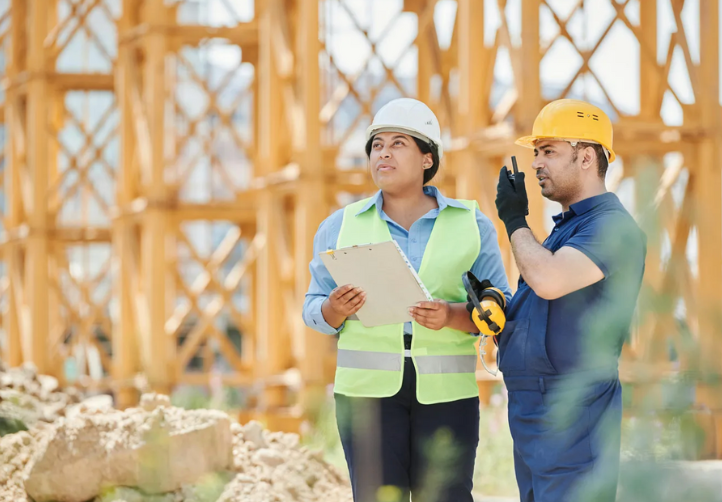By Haley Kadish & Lisette Partelow
This article originally appeared on Medium
Community Benefits Agreements (CBAs) are key to implementing equitable economic development projects through the Bipartisan Infrastructure Law. They are formal contracts between community groups, government, and developers. CBAs make sure that developers invest in communities in ways that promote quality jobs and economic mobility as they restructure cities. With strong local support, CBAs let communities have a say in projects and foster workforce development, making sure they meet specific needs like hiring locals and protecting the environment. With an increase in federal funding available for infrastructure projects, it’s vital to spend it in ways that will benefit communities long term, especially as it relates to developing diverse, local talent.
What is a community benefits agreement?
Community benefits agreements (CBAs) are “legal agreements between community benefit groups and developers, stipulating the benefits a developer agrees to fund or furnish, in exchange for community support of a project.” (Department of Energy, Office of Energy Justice and Equity). They are intended to ensure that local communities reap the benefits of economic development projects.
“Community benefit groups” can be organizations like neighborhood associations, other community-based and nonprofit organizations, labor unions, and other community stakeholders such as workforce development organizations. The “developer” can be a for-profit company, but in some instances it is a local government or governmental entity.
Why CBA’s are useful for local government leaders
By bringing the community into negotiations early, CBAs can help developers avoid lengthy and contentious public hearings and processes for zoning, approvals, permitting, etc. Sometimes CBAs are negotiated between community benefit groups and developers alone before going through the regulatory approval process for a project, but in other instances local government encourages developers to negotiate with community organizations and plays a more active role in the negotiations (e.g. by establishing city policies on CBAs or providing incentives for bidders who establish CBAs).
CBAs can help local government officials make informed choices about potential projects because they provide evidence of community support. CBAs work best at holding developers accountable for providing community benefits if local government officials approve the CBA or incorporate it into their agreement with a developer.
CBAs are also popular. Fifty-nine percent of local voters report that they support CBAs and 62% say that they would support the use of a CBA for a development project in their community.
“Through CBAs, communities are now playing a vibrant role in helping to make decisions that support the families and children who live in the communities where development is taking place.” — Anne E. Casey Foundation
Common benefits included in a CBA
The benefits in a CBA are flexible and can be tailored to meet community needs. Some communities also have benefits that they expect to be included consistently in any project.
Examples of benefits commonly included in CBAs¹:
- Local or targeted hiring (e.g. prioritize hiring in neighborhood adjacent to the project) and job creation commitments
- Wage and benefit agreements, such as a living wage requirement or stable scheduling agreements
- Workforce training investments such as apprenticeships, pre-apprenticeships or other earn and learn models
- Affordable housing commitments
- Educational partnerships with local schools
- Supports for or prioritization of small and local businesses
- Environmental benefits or actions to reduce the environmental impact of a project
- Construction of community resources like parks and recreational facilities or childcare centers
Example infrastructure projects that could include a CBA
Project Type: Affordable housing development
City example(s):
- National Community Reinvestment Coalition’s CBAs with developers in New York City
- Redevelopment of Yesler Terrace in Seattle
Relevant federal funding/financing opportunities:
- IRA Direct Pay tax credits
- Several EPA programs, see complete guide here
- Weatherization Assistance Program
- Greenhouse Gas Reduction Fund (GGRF)
Project Type: Public transportation (bus, subway, etc.)
City example(s):
- Burlington Bus project
- Beltline development projects in Atlanta
- Example CBAs between a jobs nonprofit and bus and rail building companies
Relevant federal funding/financing opportunities:
Project Type: Ports and airports (including projects to reduce environmental impact and noise and air pollution)
City example(s):
- Los Angeles International Airport/LAX (considered a model/seminal CBA)
- JFK Airport CBA
- Hunters Point Shipyard
- Port of Oakland (p. 8)
Relevant federal funding/financing opportunities:
Project Type: Municipal building construction or renovation (including decarbonization or energy efficiency improvements)
City example(s):
Relevant federal funding/financing opportunities:
Project Type: Community solar or renewable energy
City example(s):
- Cincinnati solar procurement project (p.6)
- Several case study cities in this Wind Energy Community Benefits Guide
Relevant federal funding/financing opportunities:
- Community Solar resources from Department of Energy (DOE), including financing resources
- GGRF: Solar for All
Project Type: Pedestrian safety initiatives
City example(s):
- No CBAs specific to this theme, but pedestrian and bicyclist safety can be included as a part of mixed-use neighborhood development CBAs
Relevant federal funding/financing opportunities:
Project Type: Wastewater and sewage
City example(s):
Relevant federal funding/financing opportunities:
- Clean Water State Revolving Fund (CWSRF)
- WaterSMART grants
Project Type: Transportation resilience projects
City example(s):
- No CBAs specific to this theme, but improving resilience to climate change or preventing environmental impacts that would make a neighborhood more vulnerable could be included as a community benefit in a CBA
Relevant federal funding/financing opportunities:
Project Type: Redevelopment and revitalization
City example(s):
- Gates Cherokee CBA in Denver, CO
- Sports stadiums like one for the Pittsburgh Penguins and the Nashville Soccer Club
Relevant federal funding/financing opportunities:
Additional Resources
- CBA examples database (includes actual contracts)
- Department of Energy Community Benefits Agreement Resource Guide
- CBA Toolkit by PolicyLink






